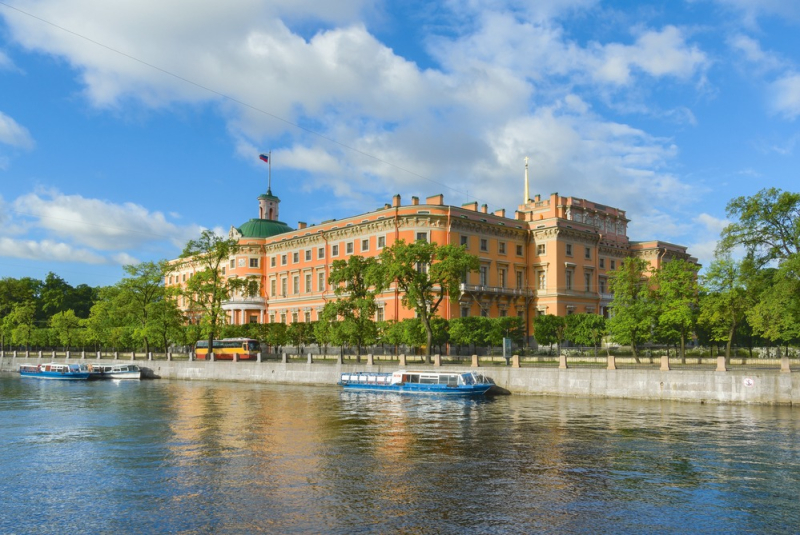Mikhailovsky (St. Michael’s) Castle stands right in the city center, just a few steps away from such famous sights as the Russian Museum and the Summer Garden; yet, the surrounding area is quiet and somehow desolate, you won’t see crowds of tourists or even many people nearby. Partially, that may be thanks to Mikhailovskiy being a moated castle - actually, it’s the only construction of this type in Russia. Surrounded by water, it looks somewhat distant, unapproachable, even unwelcoming; the other reason for this elusiveness lies in its peculiar design. All of its four facades are in different styles, similar in color only, so that an uninitiated person can even mistake them for being part of different buildings. What’s more, its fortified gate behind what was once a drawbridge somehow denies the very idea of entering. Yet, the strange, almost illusory castle dominates the surrounding area; for some, it even ends up becoming one of those places one always wants to check out, but never really does.
Besides its strange outward appearance, Mikhailovsky Castle has an even stranger history. It was built by Pavel I, Russia’s 8th and arguably the most eccentric and bizarre emperor - which explains the castle's unique design, as the emperor drew the initial sketches himself. Having ruled for only four years, Pavel has the reputation of one of the most controversial people in Russian history; during this short time, he attempted to radically - and erratically - change everything about the country, from international politics to fashion. The castle was his favorite project and refuge, as Pavel wasn’t exactly popular; he even built a 3.5 kilometer underground escape tunnel to the Vorontsov Palace, which might have been the longest one in Europe at that time. As the story goes, he moved in before the castle was completed, while the stone and plaster was still damp, which created an eerie fog in its many rooms.
The refuge part didn’t work out really well, as Pavel died there in less than 40 days after moving in - he was brutally murdered in his own bedroom, betrayed by one of his closest attendants count Pahlen and a group of conspirators - struck with a sword, strangled and then beaten to death. After his death, his son Alexander acceded to the throne. Alexander knew of the conspiracy, so his father’s death haunted him to the end of his life; he moved the imperial residence back to the Winter Palace, and the castle was handed over to a military engineering school, which is the reason for its second name - the Engineering Castle.
Yet, different stories and myths continued to circle around; the most popular one about Pavel’s ghost haunting the palace was reflected in the novel “Ghost of the Engineer’s Castle” by N. Leskov. By the way, Fyodor Dostoyevsky, one of Russia’s most famous writers, was once a cadet at its Engineer’s School. Another myth is about a treasure box with mystical relics hidden somewhere in the Castle - Pavel once gave refuge to Knights Hospitaller and was named their Grand Master, so tales like these circle around just any place that has to do with him. Also, if you look to the right and downwards while standing on Castle’s bridge, you might notice a strange metal soldier standing in a stone niche - that little fellow is said to predict the future if one throws a coin at his head. In fact, all these myths inspired the Russian Geographical Society to conduct an unofficial study of paranormal activity in the Castle in 1980, which included data gathering, filming and even such things as dowsing - which only further bolstered the Castle’s grim reputation.
Today, the Castle is part of the Russian Museum, and hosts different art exhibitions. Though not as big and diverse as that of the main branch, its collection is definitely worth seeing; among the notable permanent exhibitions are the “Faces of Russia”, which displays portraits of Russian citizens of different social standing from different times, from Emperors and renowned political and cultural figures to common folk, an exhibition on St. Petersburg’s society and culture of the 19th century (among the everyday items displayed there are several snuffboxes, including one that belonged to Count Zubov, one of Paul’s murderers - some of them later stated that it was used to land the final blow), and the Open Sculpture Fund where you can see Russian sculptures from the end of the nineteenth century to these days, including the avant-garde works of early twentieth and modern contemporary and experimental art. The temporary exhibitions are mostly on classical art, usually dedicated to a specific artist. Be sure to check the museum’s webpage to learn what’s on, and mind that you can only enter the Castle’s third floor as a part of a tour on specific days (I strongly advise you to do that, as otherwise the impression would be incomplete).
So, if you like St. Petersburg and want to get a better feel of it, Mikhailovsky Castle is a place you should absolutely check out. Immerse yourself in the grim atmosphere of the Russian past, walk the Castle’s courtyard that is so much like a trap, and wander its resounding halls; let your imagination go wild and feel the stare of old portraits - this will definitely become an experience you won’t forget.




